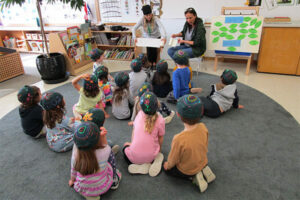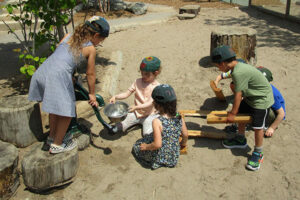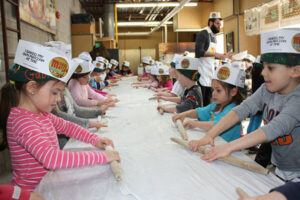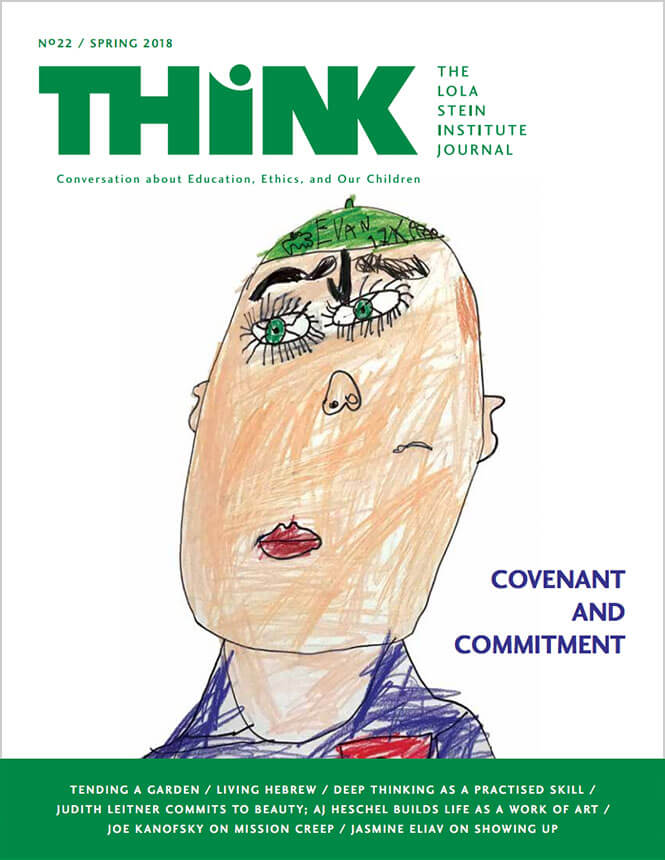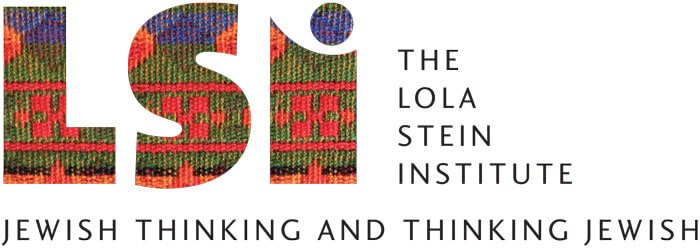- How We Teach

- First Column
- Second Column
- Third Column
- Case Studies

- First Column
- Second Column
- Culture & Community

- First Column
- Second Column
- News & Views

- Admissions

- First Column
- Second Column
- Support Us

- About

- First Column
- Second Column
- Parent Hub
- Attend an Open House
- Take a Tour
- Donate Now
- Calendar
- Blog
- 416-635-1876
- Search
Commitment to Deep Thinking
by
The biblical account of the creation of the world begins with depth: “When God began to create the heavens and the earth, the earth was a tumult and a tumble, and the spirit of God hovered above the face of the deep” (Genesis 1:1-2).
Those who dismiss the biblical account – how could the world be created in seven days? -read this text superficially, ignoring its appeal to depth. The first chapter of Genesis is structured in layers; each day of creation is an iteration adding to and enriching what comes before it – like a painting that begins in simple shades of “dark and light” and develops to become a vibrant, full-colour work of art. Genesis commits us, in multiple ways, to think deeply.
In his acclaimed book, The Shallows: What the Internet Is Doing to Our Brains, Nicholas Carr describes the Internet as the latest evidence of Marshall McLuhan’s adage “The medium is the message.” Carr writes:
Whether I’m online or not, my mind now expects to take in information the way the Net distributes it: in a swiftly moving stream of particles. Once I was a scuba diver in the sea of words. Now I zip along the surface like a guy on a Jet Ski.1
With its ability to hyperlink information, the Internet offers an easy and vast sea of data. Unfortunately, without deep thinking, the knowledge that it delivers up is random, meaningless. Innovation and discovery rarely come from skimming, sampling, and collating; the face of creation relates to the deep.
Other than the practice of safe surfing – heads up for sharks and phishing – we educators need not allocate precious teaching time showing our students how to use the Internet. Born into the medium, they swim in it better than we do. But, how to think in the depths is another matter. Partly because deep thinking swims against the current, and partly because it involves techniques that are not self-evident. navigating deep waters well requires real skill.
My commitment, as a teacher and school leader, is to enable and empower students and teachers to think deeply; my toolkit for doing this contains seven techniques and practices.
- Being in the Question
Deep thinking means engagement with dilemmas that are complex and have no immediate solutions; the deep thinker needs first to feel okay being in the question. Biblical creation begins with Tohu Vavohu – tumble, tumult, chaos, messiness. Deep thinkers live with cognitive dissonance and learn to work steadily through a problem; students must tolerate the discomfort of not knowing and hold open the questions that have no answers. Learning to be in the question requires open-ended inquiry, compound multi-stage problems, and project -based activities. Mindfulness practices – meditation or prayer – provide contemplation and wonder without immediate resolution.
- Iteration
The Genesis text continues, “and there was evening and there was morning.” Again and again it cycles back to the same thought. Iterative thinking also returns repeatedly to the same question, but at increasingly deeper levels. It assumes that solutions achieved are provisional, and that even better solutions await discovery. Each year, the Jewish calendar returns us to familiar moments – Rosh Hashanah, Yom Kippur, Sukkot, Chanukah, Purim, Pesach, Shavuot. Each time we revisit, we learn something new and go deeper.
- Revision
Connected to iteration is the willingness to revise. Revisiting and revising one’s work is a key practice in deep thinking; each revision makes a story, essay, or mathematic solution more elegant. There is tremendous value in using an eraser (or the delete key), in rewriting a paragraph, and composing two, three, or even four drafts to achieve a better outcome. The ethical version of this skill is the rabbinic concept of Teshuva, which means to reflect on and revise one’s actions.
- Experimentation
Deep thinkers explore and test the sustainability of their ideas. Experiments lie at the root of the Scientific Method, which renders many of humanity’s greatest insights. What makes the Scientific Method credible is the process of trial and error, with the possibility, even probability, that an experiment will not support a hypothesis. “Mistakes” or “errors” can signal that thinking is reaching a new frontier.
- Introspection and Dialogue
Self-knowledge is essential to deep thinking, in terms of a capacity to acknowledge and screen out one’s biases, assumptions, and beliefs. The mindset includes skill to focus, concentrate, and regulate one’s impulses. The complement to this self-awareness is the ability to engage in honest dialogue with others, to register alternative points of view and to learn from difference.
- Thinking in the Disciplines
Deep thinkers learn to view problems through different frameworks and appreciate the filtering of various lenses. This is the true value of learning the diverse ways of thinking, which come to learners, in school tradition, as “academic disciplines” and “subjects,” such as science, math, writing, ethics, and so on. Deep thinkers regard academic disciplines as ways of thinking, not storehouses of information. The Internet can tell us that the universe is 14 billion years old and was created with a Big Bang; deeper learning shares the evidence that scientists used to develop the explanation; deeper yet is to understand how the evidence was discovered by the Scientific Method; and still more profound is to practise the Scientific Method oneself and internalize the system.
- Awe and Wonder
Rabbi A.J. Heschel reminds us. “Wonder, not doubt. is the beginning of knowledge.” Wonder is the amazement that drives the desire for complex knowledge and far-reaching comprehension. It is not a feeling that can be assuaged by googling for an answer; wonder is a constant openness to the depths of what remains mysterious.
Like the seven days of creation, these seven practices prepare students for a deep and wondrous future. To solve important problems and create the next wave of innovation, we must all remain willing to go deeper. Albert Einstein is credited with saying, “No problem can be solved from the same level of consciousness that created it.”
Today, as knowledge swims in shallow waters, commitment among educators to deep thinking is paramount. Like the biblical Nachshon ben Aminadav, educators must be willing to wade out from the shores of rote learning and superficial curricula. Teachers must have faith in their own experience of the depths to help children explore their own deep thinking and realize their full potential. We must remember that children can swim in the deep end of learning. Moses called for the waters of the Reed Sea to part so the lsraelites could move forward, but the miracle happened and the path opened only when Nachshon went into the deep.
1 Nicholas Carr, The Shallows: What the lnternet Is Doing to our Brains (New York: W.W. Norton, 2011), p. 7.
Greg Beiles , Director of The Lola Stein Institute and Head of School of The Toronto Heschel SchoolGreg Beiles became Director of the Lola Stein Institute in 2010 and Head of School at the Toronto Heschel School in 2014. For the 18 years prior to being named Head of School, Greg worked and taught at the school is increasingly senior capacities. From 2008 to 2010 he also served as Director of Curriculum and Training at the Lola Stein Institute.
Greg holds an MA in the Philosophy of Education from The Ontario Institute for Studies an Education and is a PhD Candidate at the Centre for the Study of Religion, both at the University of Toronto. His research explores a re-framed vision for Jewish education.
Greg’s publications include “Jewish education and pluralistic engagement”, in Discipline, Devotion and Dissent: The promise and problems of Jewish, Catholic and Islamic schooling, ed. G. McDonough, M. Memon, and A. Mintz. In the PEJE publication, Jewish Day School Education, he published “And you shall love your God.” His column “Awe and Wonder” appears regularly in think magazine; his titles include; “What Makes a School Jewish?” and “Education for the Next Generation: Thinking in the Disciplines.” Greg has led workshops and presentations in a variety of settings, including The Bridges Conference at the Banff, York University, the Jewish Federation of Ottawa, and the Lola Stein Institute, A few workshops titles include: A Critical Thinking Approach to Numeracy; Five senses and the Five Books of Moses; Metaphor and God; Understanding Understanding; Discipline & Wonder: Integrating the Theories of A.J. Heschel and Howard Gardener in an Educational Context.
Special Feature
Our Sages Tell Us
Perspectives
 The Lola Stein Institute (LSI) is a centre of inventive educational thinking and addresses the challenge to re-frame schooling for the exigencies of our times.
The Lola Stein Institute (LSI) is a centre of inventive educational thinking and addresses the challenge to re-frame schooling for the exigencies of our times.

